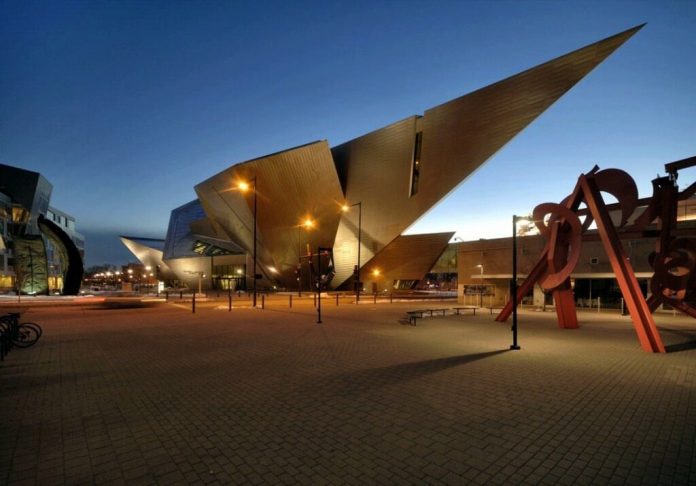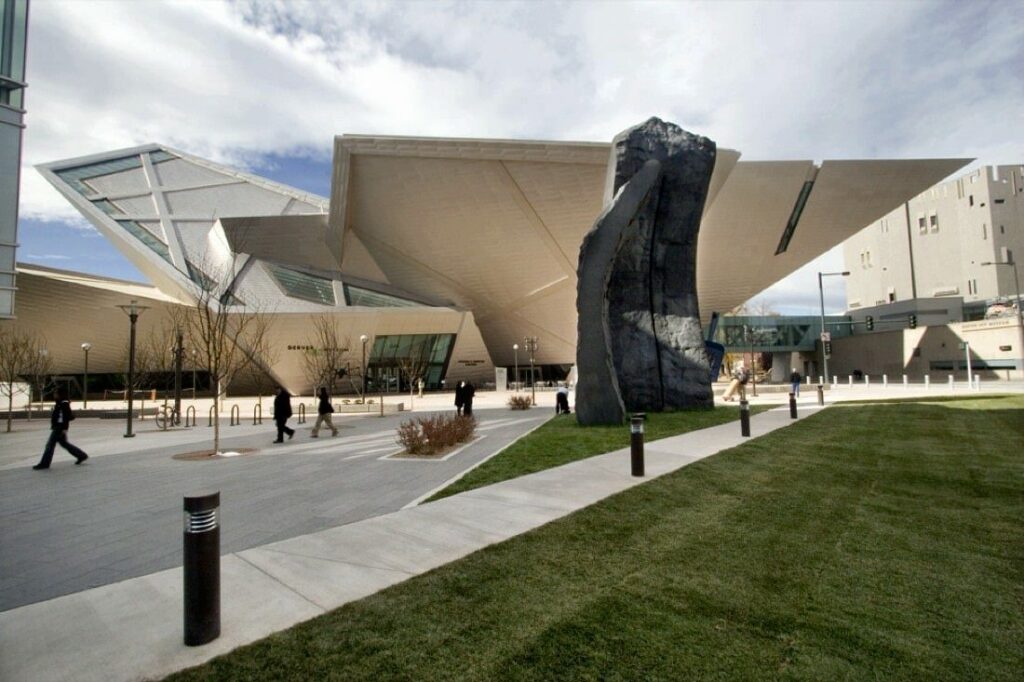Every year Denver hosts the popular Cherry Creek Arts Festival, and in 2008 two major cultural events of national importance will be held in addition to it: the Performing Arts Convention and the American Museum Association Convention.
In the U.S. the capital of Colorado is usually considered to be the city of intellectuals: there are a theater troupe and an orchestra, which has gained popularity throughout the country, 8 institutions of higher education, the fundamental library, as well as many museums, the number of which is constantly growing.
With the advent of the Frederick S. Hamilton building, the museum workers were able to extract more than 700 works from the vaults. The exhibits were divided between the two buildings as follows: in the northern (old) building there were European paintings, sculpture, and textiles, the art of Asia, pre-Columbian and pre-Spanish America, as well as examples of American Indian art; in the southern (new) building there is the art of the USA, Africa, Oceania and modern art of different countries. In addition, temporary exhibitions will be held in the new building. Daniel Libeskind has designed more than one museum over the years. There are three Jewish museums on his account only: two realized and one under construction. He also remembers the Military Museum in Manchester, the new building of the Royal Museum of Ontario, and many other objects. Some critics accuse Libeskind of banal exporting his project of the Jewish Museum in Berlin to Denver, but the architect claims that the concept of the future building was invented by flying up to Denver and looking out of the plane window on the Rocky Mountains.
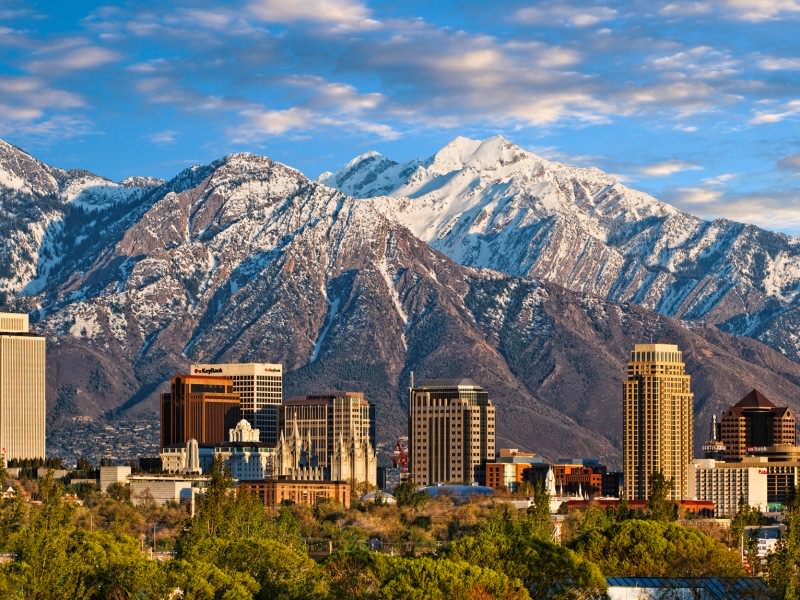
Continuing his signature style, the architect once again set a difficult task for the designers – the proposed solution is unique for the United States. When looking at the building of the Museum of Art in Denver, it seems that it falls apart into several parts. There is not a single centered node in the structure, and all the nodes are different; up to eight rods may intersect in them. However, in general, the structure is stable, which is achieved by using steel slabs embedded in reinforced concrete foundations. They are attached to all the supporting columns. Thus, the floor becomes a kind of screed for the walls, and all beams of the structure mostly work on stretching. For calculation, the designers used a special 3D model. By the way, for all the non-standard design thanks to this model all the elements were able to perform at the plant, and at the site, they were only collected.
Not only all joints of the main structure were calculated, but also the placement of holes in the bearing elements for the laying of engineering communications. Nevertheless, in case of any problems, a total of 19 architects and engineers constantly worked on the construction site. To organize the construction process, the so-called 4D model was used (fourth dimension – time). The external forms of the building accurately reflect its internal structure. The authors of the project proposed a wide range of different spaces of very intricate forms. At the entrance, a visitor enters a 37.2 m high atrium that pierces through the building. It is formed by walls located at different angles to each other, none of which is vertical. The elongated upward space seems to wriggle in the primordial dance. It echoes the movement of the walls and the main staircase leading from the 1st to the 4th floor. All this is illuminated by a lantern of upper light, and on the walls appear fanciful shadows. On the 1st floor, the visitor finds a large lobby, information desks, ticket offices, a museum store, and one room for temporary exhibitions at Gallagher Family Gallery.
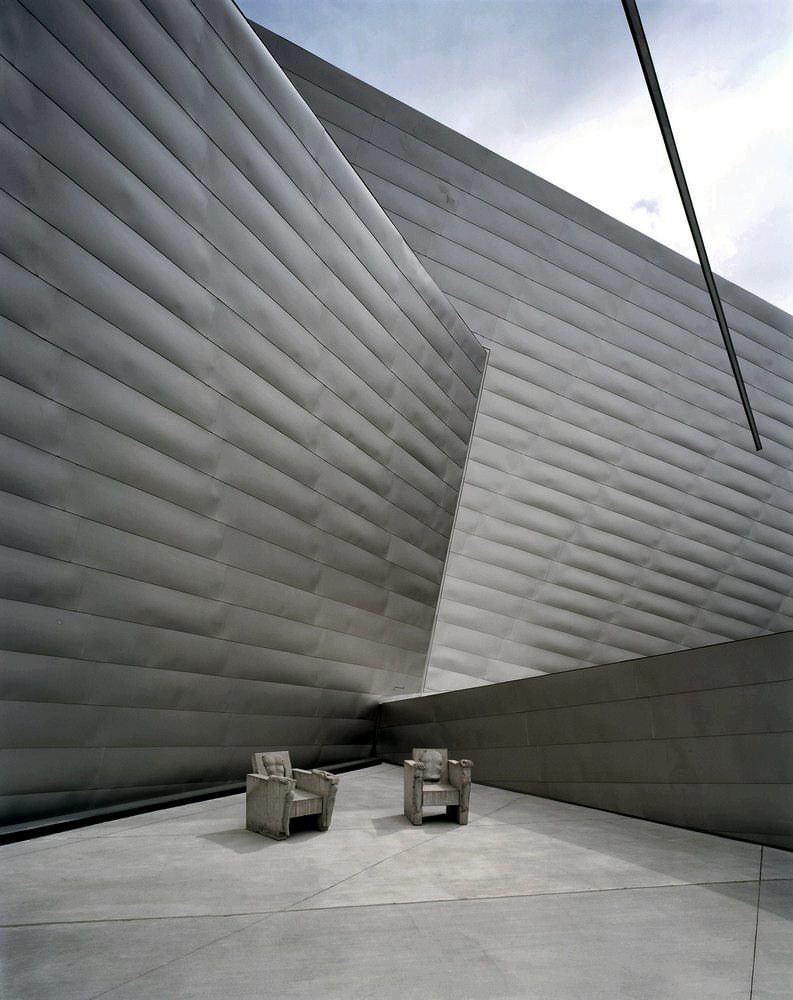
In general, on the 2nd floor, there is an exhibition of U.S. art: canvases by Albert Bierstadt, Frederick Remington, Andy Warhol, Alexander Calder, and other famous artists. Above – the halls of Oceania and contemporary art.
In the latter, you can see works by Picasso, Matisse, Modigliani. Here is also the second or small atrium. In addition, at this level, right under the “nose” of the structure, there is an open terrace with an exposition of sculpture, which offers a view of the mountains and downtown. On the top floor, there are exhibited African art objects. There is also one underground level, almost entirely dedicated to storage; there is also a lecture hall for 280 seats. It should be said that in this building the area of extra-exhibition spaces for visitors is equal to the area of the halls of the permanent exposition. This is partly due to museum workers who, in the process of designing, asked architects to increase the size of aisles and halls. Many critics consider the abundance of non-vertical walls a shortcoming of the building. However, the museum workers are not so categorical: they are convinced that the architecture of the building is one of the museum attractions. The curators found a good use for the flat walls: they wittily placed textiles and carpets on them. And for the rooms, where vertical walls were needed, they developed a plan of partitions arrangement.
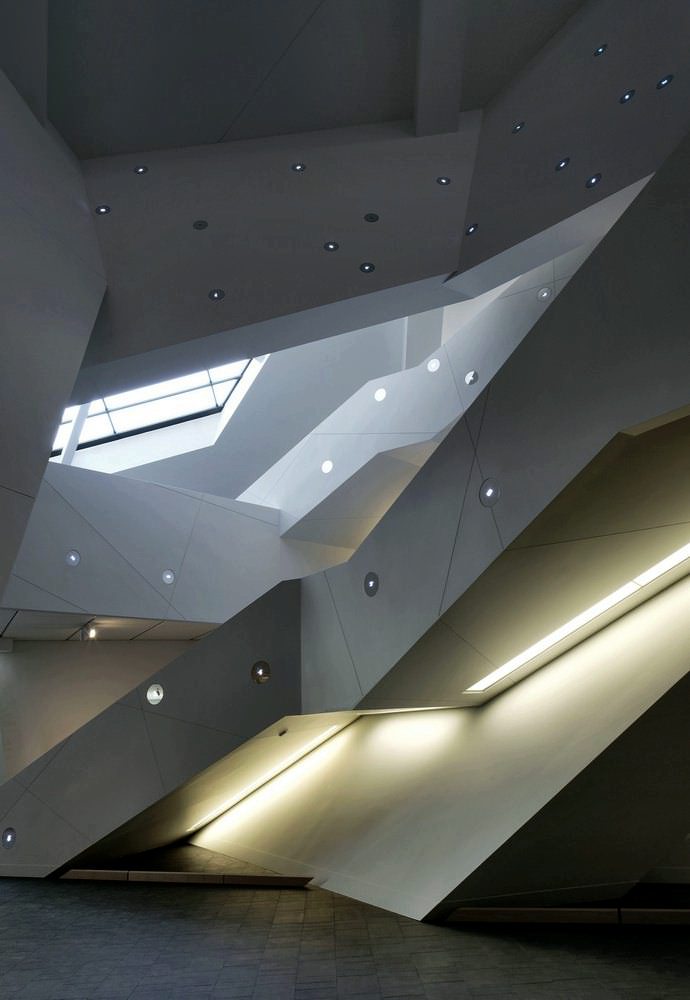
The Libeskind studio has already received an order from the owners of a plot adjacent to the museum to design two apartment buildings and a parking lot. The relevance of the project proposed by Libeskind also confirms its financial history. The fact is that in the U.S., unlike Russia, most museums exist at the expense of trusteeship funds. The Denver Museum is no exception. So the building of Frederick S. Hamilton was built exclusively on charitable donations. By the way, it was named after the most active patron of the museum.
Denver Art Museum
The Denver Museum has two buildings – the northern and southern ones. The Northern Corps was designed and built by an Italian architect in 1983. The building of the old museum building was built in the style of the 17th-century castle with a modern facade This building of the museum in 2019 is in the process of restoration work.
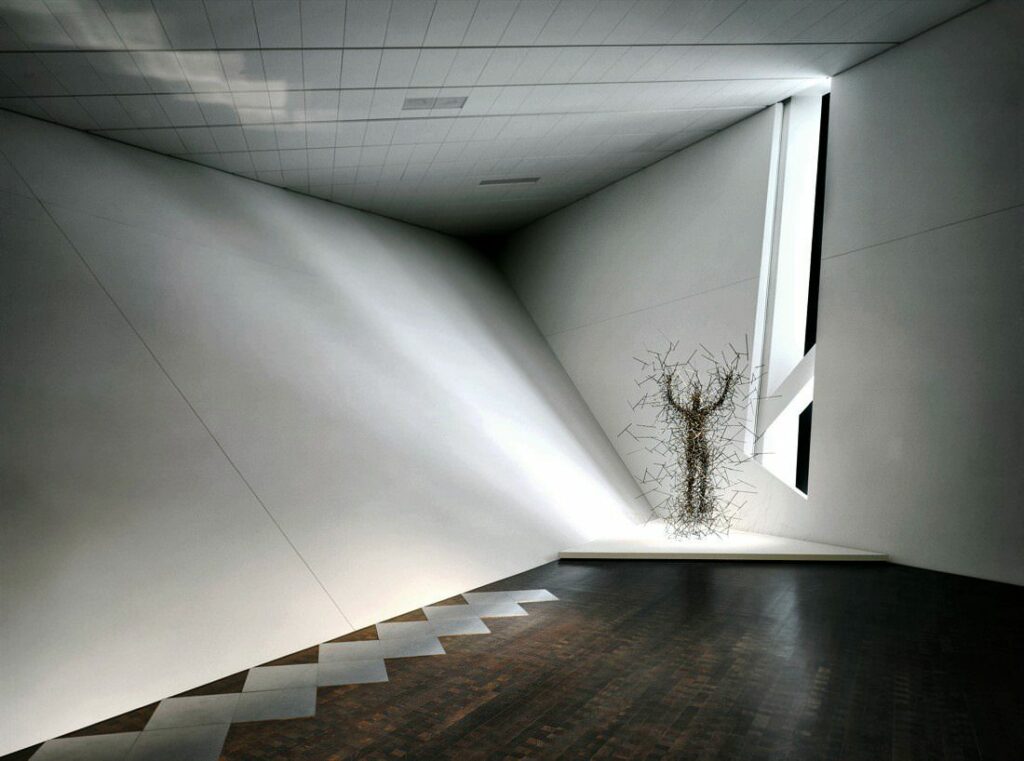
The new building of the museum – Hamilton Building / Hamilton Building was built in 2006 to expand the museum’s exposition, and the new building itself has become an architectural work of art. The new building also serves as the main entrance to the rest of the museum complex.
Although the old part of the museum attracts attention, it is the building of the new building designed by Daniel Libeskind that will change your perception of art and architecture.
The architect’s task was to renew the museum’s appearance in such a way that the building’s appearance reflected the mood of the exhibitions of this building. The main collection of the new museum building is Modern and Contemporary Art.
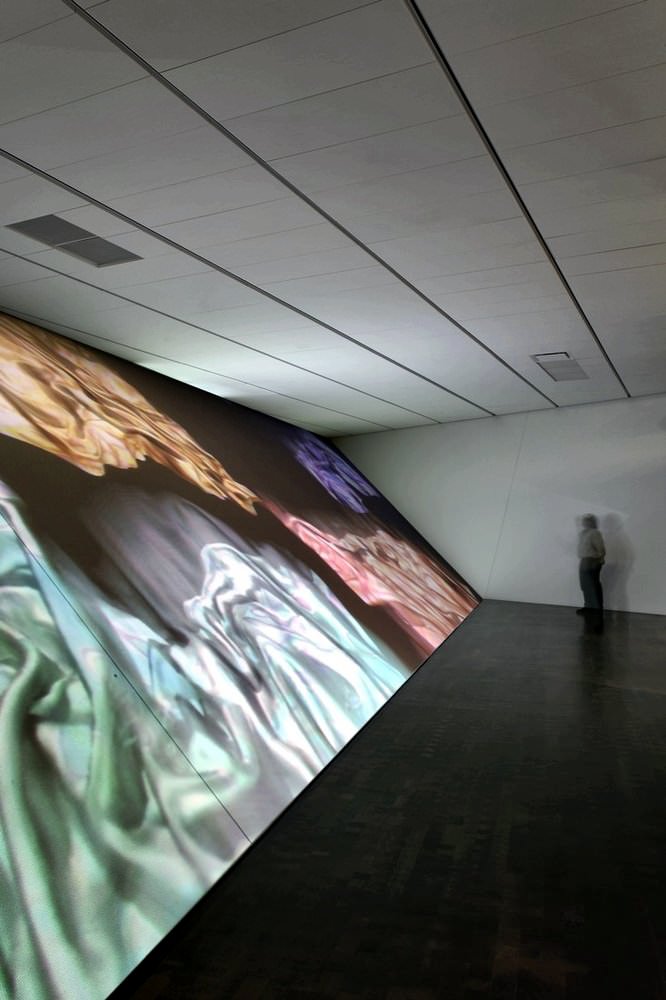
Angular omnidirectional design is mounted on a 2 740-tonne support consisting of 3100 steel blocks. One of the corner elements hangs over the street at a height of 15.5 meters and extends over the street for almost 10 meters.
The design of the building, using angular structural elements and flat surfaces between the faces, simulates the landscape of the nearby Rocky Mountains, as well as geometric crystals found at the foot of the mountains near Denver.
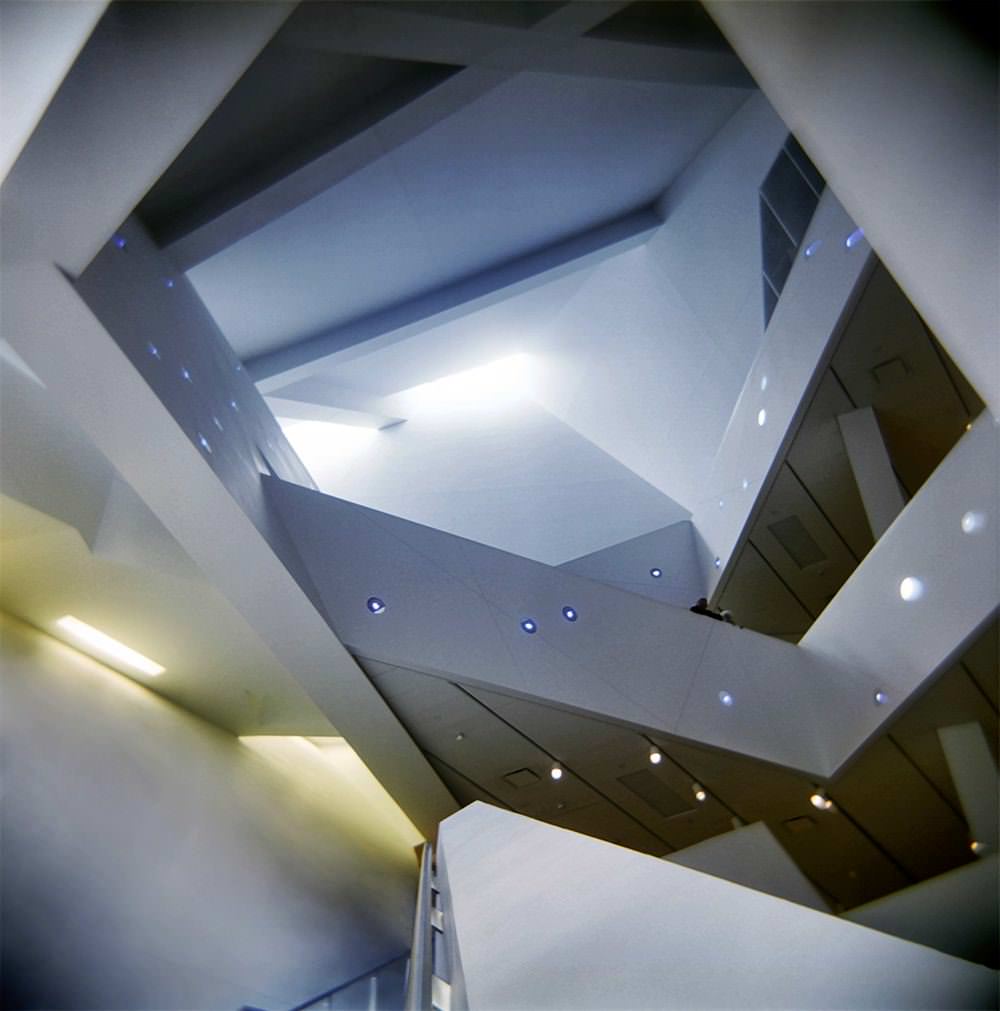
From some angles, the design of the building resembles an arrow or a bird pointing to the sky.
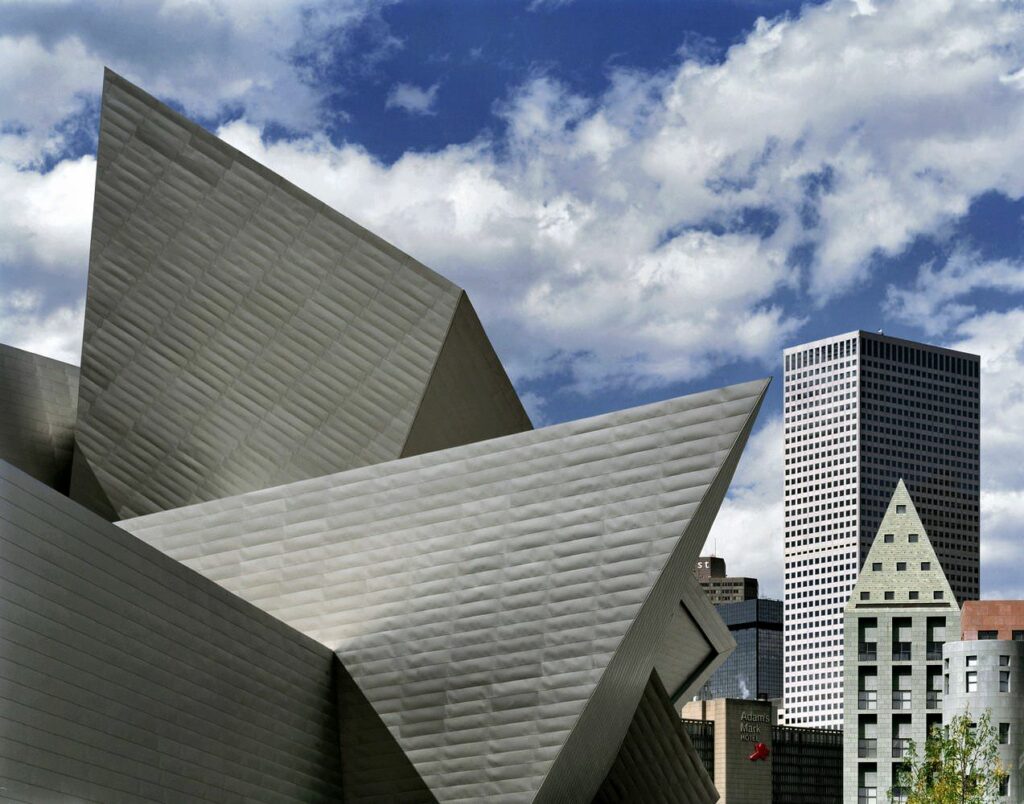
Inside the building of complex architecture, there is a space where installations of modern art and modern abstract painting look very appropriate. The building has many sharp corners and stairs because of its angular shapes and windows.
The modern appearance that perfectly harmonizes with the museum’s content and with the building of the museum’s northern building is a true work of world architecture.
Connoisseurs of art and architecture, we plan to visit the Denver Museum of Art in Denver, USA. The museum will not leave you indifferent and will be able to attract attention not only with its exhibits but also with its appearance.
The Denver Art Gallery
The Denver Art Gallery houses an extensive collection of artworks from various world cultures and historical periods. It presents folk art from Asia, Africa, and Oceania, as well as paintings by European and American artists of the XIX century, in particular representatives of the Renaissance, Impressionism and Art Nouveau. Museum’s funds are concentrated on the collection of local Pre-Columbian American Indians’ art.
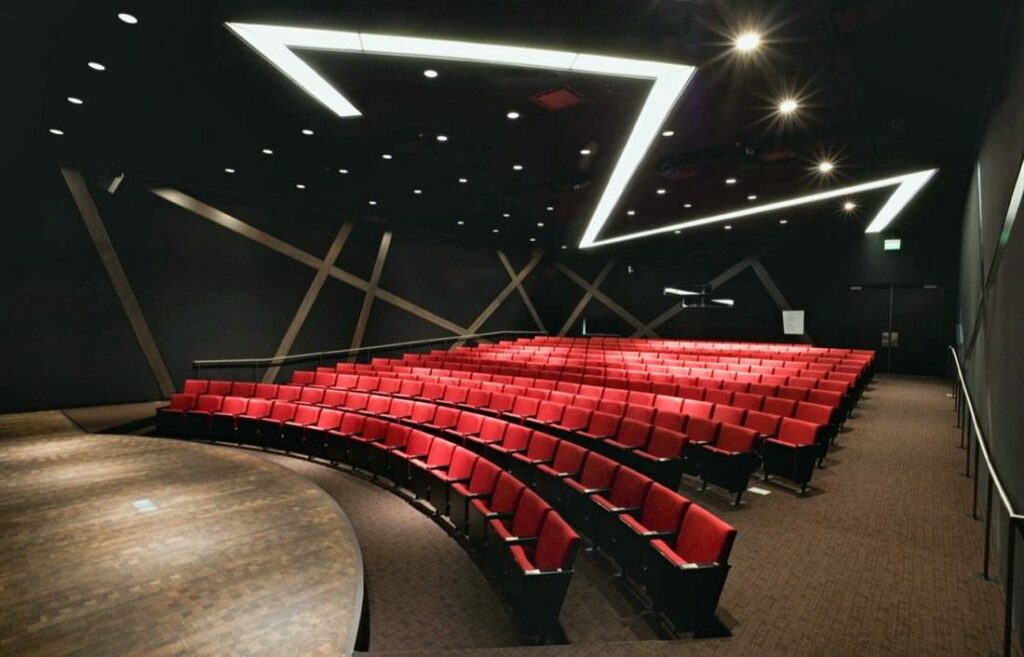
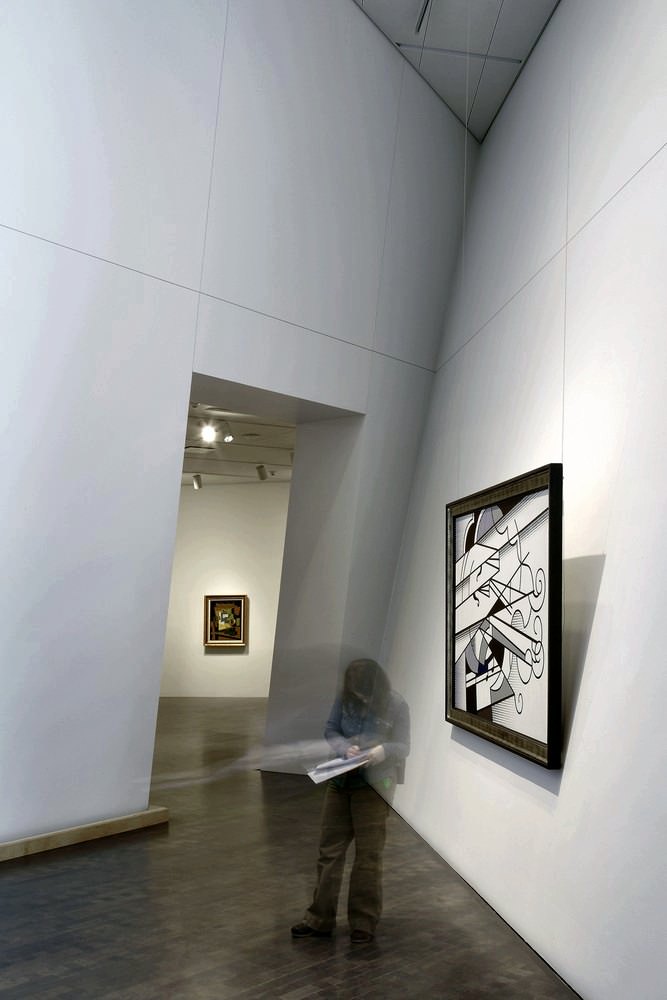
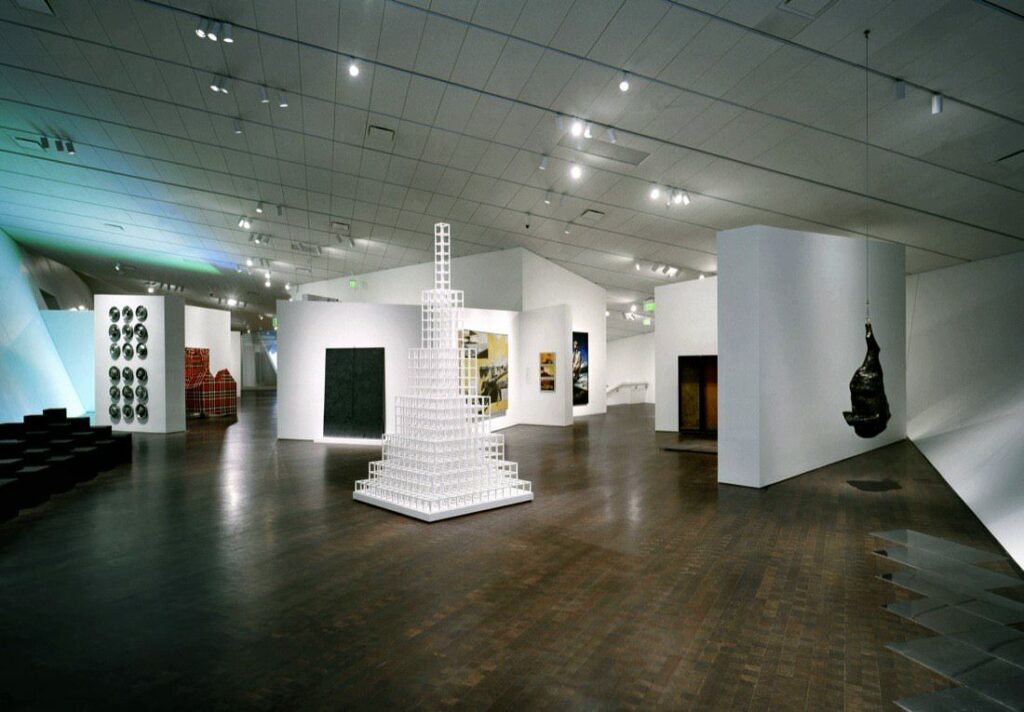
Looking at the chiseled white Denver City and County Building, you don’t immediately notice the tower of the medieval castle on the left… This, of course, is not a greeting from antiquity (wherein the USA it comes from), but rather a greeting from Italian architect Gio Ponti.
Center Library
A stone’s throw from the museum is a tower in an academic cap. This tower is probably the most remarkable part of the complex of the Central Public Library of Denver.
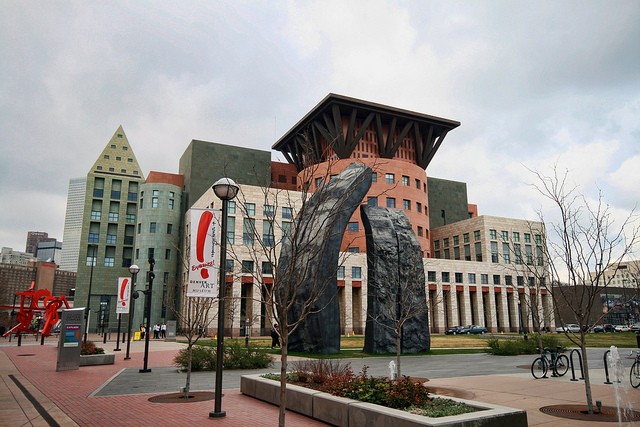
The Library was built in 1955 on the site of a building that was once a car showroom, where the Denvers could buy the “Tin of Lizzie”, under this miracle name was formerly known as Ford T.
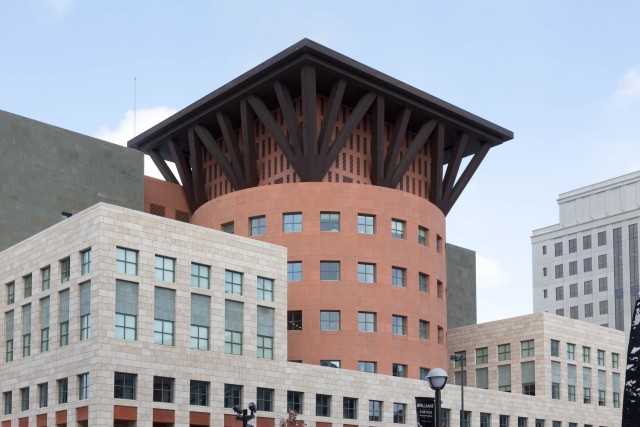
Perhaps there is some highlight in the fact that the car showroom has become a library, now it would rather the opposite happened.
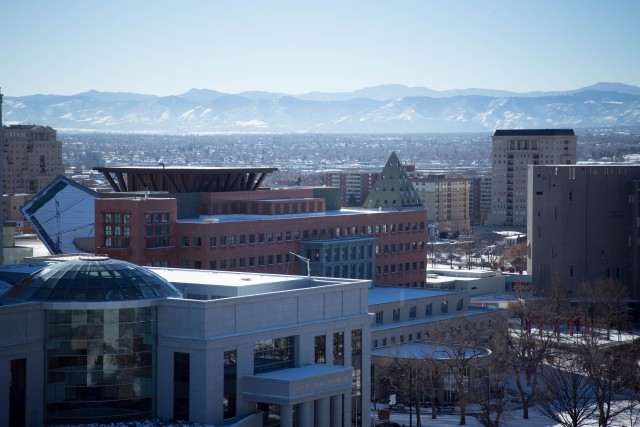
This is what the library building on top looks like.
The library complex looks colorful and even original in something… And architecture… Let’s say, it is the most harmonious “intertwining” of two seemingly incompatible styles.
The fact is that in 1955, the style of modernism in architecture was more than popular … The old building of the library complex is a typical example of the Intranational style (one of the trends in modernism).
The left side of the building is the “old part” of the Library
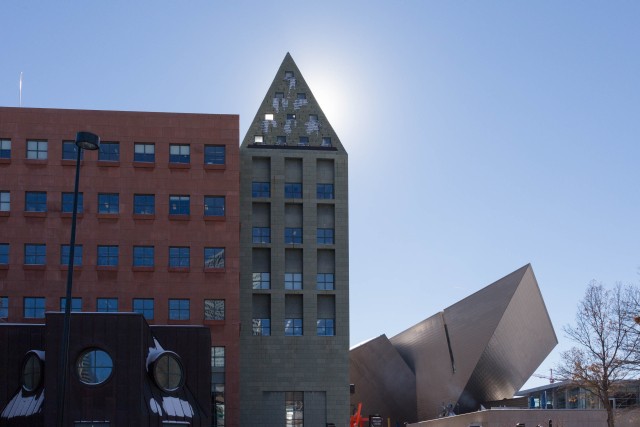
And in 1995, to the gray and slightly dull building added the colorfulness and uniqueness of post-modernism, “putting” red, green, and blue geometric shapes: cylinders, dice, parallelepipeds, and pyramids…
Museum interior
The main tasks of the museum, one of the largest in the country and the largest on the expanses from Chicago to the West Coast, are to preserve traditions and at the same time to give birth to new art (both old and modern are exhibited here).
The Denver Museum offers the widest view of American history – from ancient times (Inca and other pre-Columbian cultures) to the works of an already formed nation, such as it is known today.

Department of European and American Art – a retrospective of old art from the Middle Ages to the end of the XIX century. This collection includes works by such great masters as Claude Monet, Edgar Degas, and Camille Pissarro.
The Department of African Art has more than a thousand exhibits, revealing the art of the named continent from different sides. It becomes clear that behind similar ritual objects lies the root, ontologically and aesthetically, different perceptions of the world.

The Asia Art Department also deserves attention. It gives an idea of the traditions of Japan, India, Cambodia, and Korea.
The famous Denver collection of American Indian art “tells” stories about formidable birdlike deities and women who received mystical knowledge from their ancestors; about how bags and capes were decorated and what this decoration meant. In the halls where the meeting is exhibited, the drama of the conquered people who fell powerless before the white warriors with firearms unfold.
The Department of Pre-Columbian Civilization Art represents the majestic archaic art of the Incas, Chimu, and other peoples of Peru. The exhibits showcase this amazing culture, which originated and died in a vacuum, boiled exclusively in its own juice, making it incredibly interesting for the ordinary viewer, as well as for art historians and historians.
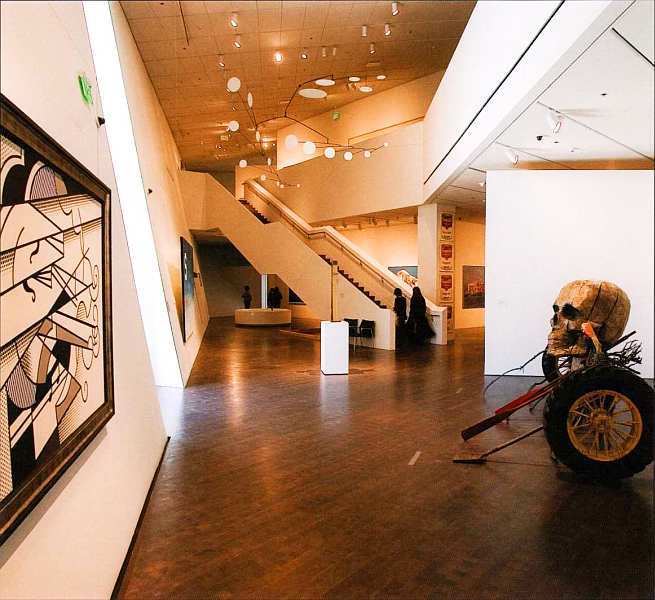
In search of its roots, the Denver Museum exhibits the art of Western America. First of all, works of XIX century painters, who investigated the nature and life of Indians. They include love for nature and at the same time, an attempt to reflect on the experience of this area and indirect ancestors – the Indians.
As a result, the museum presents the viewers an amazing kaleidoscope of life on the American land with all numerous cultures that ever existed on it, and European sources of culture that settled there since the 16th century. Thus, the Denver Museum owns a fundamental collection, from which you can tell not only the whole American history in detail but also almost the whole history of art. It should be noted that in most cases, these are very high-quality pieces of art: one cannot overestimate Monet’s “water lilies”, Arcimboldo’s “vegetable bouquets” or amazing African masks.
The museum opens wonderful worlds, and we offer the reader to plunge into them.
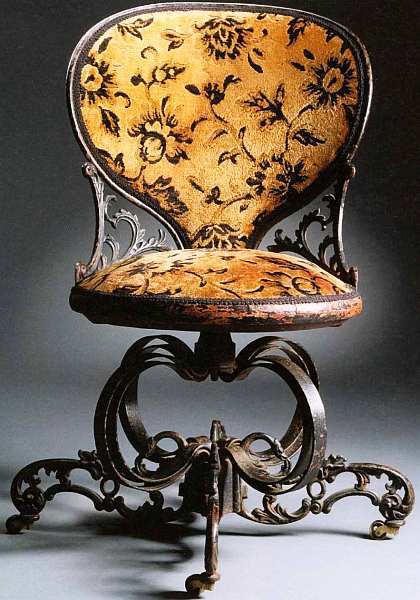
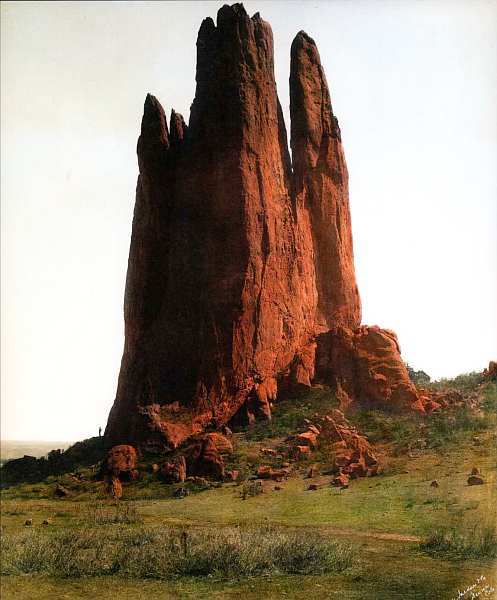
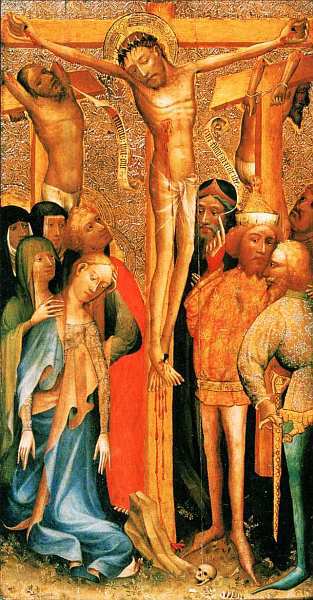
In front of the viewer is one of the few altar images that survived the secularization of the monasteries by Henry VIII Tudor during the Reformation.
The crucifixion is one of the scenes of Christ’s passion. Jesus with a crown of thorns on his head is located in the center. On the left is the Virgin Mary, surrounded by holy wives. Behind her is John the Evangelist, who turned his bright face to the Savior. On the right is a Roman centurion (commander of the 1/60 part of the legion) in medieval clothes. In the background, on the sides of Christ, there are two thieves crucified with Him on the same day. Under the cross lies the skull of Adam, marking the redemption of the original sin.
The work presented is not only a retelling of a specific biblical event, but it is also an altar image intended for prayer. The calm look of Jesus is traditional for this scene, but for the Middle Ages the emphasis on suffering is important – a weary body, sagging on thin hands, enlarged palms and feet, drawing attention to the pierced flesh. Stylistically, the Crucifixion can be classified as international Gothic with its elongated, slender figures, aspiring to the sky like spires of cathedrals. It is necessary to note the decorative character of a background and clothes in which the medieval love to the ornamental filling of planes is shown.
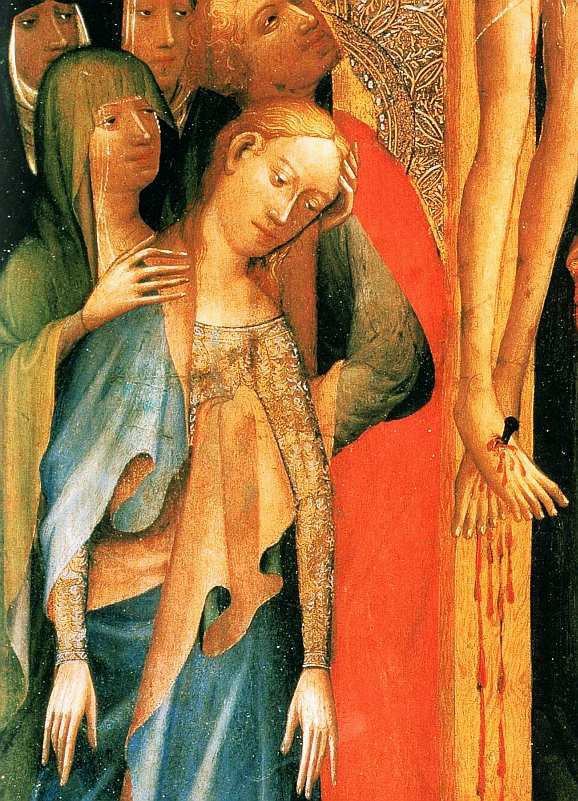

Presumably, these wooden panels decorated the cash register (wedding chest) made for the wedding of a bride from the Gonzago dynasty in Mantua and a groom from the Sforza family, the dukes who ruled Milan.
The plot goes back to Petrarch’s Triumphs, a poem that describes the victory of love over man, chastity over love, death over chastity, glory over death, time over glory, and eternity over time.
At the panel joints – exquisite decorative columns. The first board depicts the triumph of Love. The plot tells the story of the poet’s dream, in which the cupid, embodying Love, rides on a triumphant chariot, surrounded by suffering lovers – the famous historical, literary, mythological, and biblical characters. At the sight of his bow sits the bound Man, defeated by Love.
On the second panel is the triumph of Celomudria, in whose role Laura is Petrarch’s beloved. In front of her is a defeated cupid, under a flying standard with the image of an ermine, a symbol of purity, parading chaste women, saved from the destructive power of Love.
The third panel illustrates the triumph of Death, ruining everything in its path.
The work is a pure and clear manner of the High Renaissance with its tonal perspective, attention to the anatomically correct transfer of the figure, delicate color and departure from the canonical biblical themes.
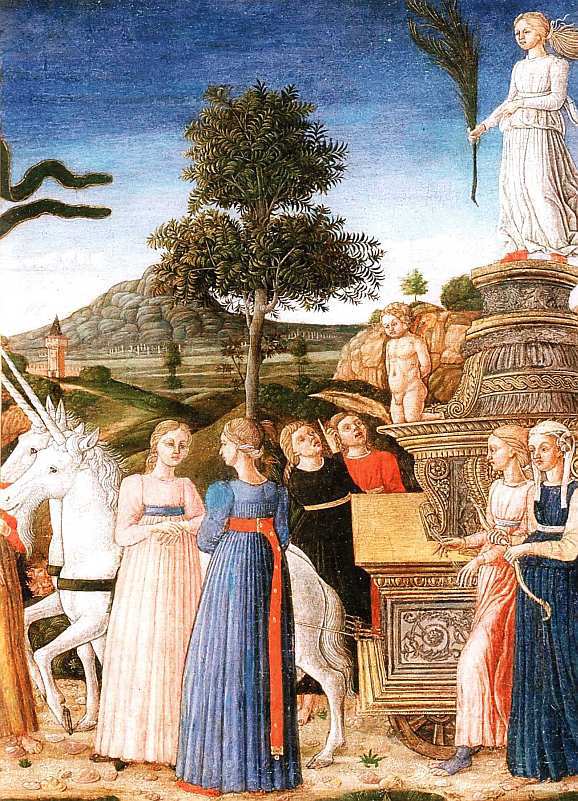
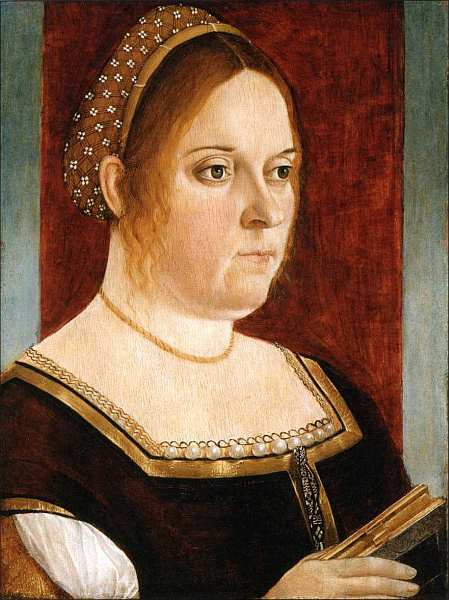
Vittore Carpaccio is one of the greatest masters of the Venetian Early Renaissance School and the most talented followers of Gentile Bellini. He is best known for his cycle of paintings for the Scuola di Santa Orsola (1490-1495, Galleria Accademia, Venice). Nine of them are dedicated to the life of St. Ursula.
It is believed that the Lady with the Book is a poetess named Girolama Ramos of Korea: in one of her sonnets, she praises this portrait, admiring the way the artist depicted her. The heroine is dressed in accordance with Venetian fashion. In the 15th century, very few women’s portraits were painted in Venice, perhaps because women occupied an insignificant place in the public life of the aristocratic society of this commercial city. Girolama was obviously an outstanding personality. The poetess experimented a lot with the form of a verse, creating love lyrics in the spirit of Petrarch, or dramatic sonnets in memory of her murdered brother.
Clearing the lacquer, made in 2009, revealed the true color of the painting, revealing the traditional Venetian beauty: fiery red hair, rich red background, painted in several translucent layers, shaded by exquisite gray and blue.
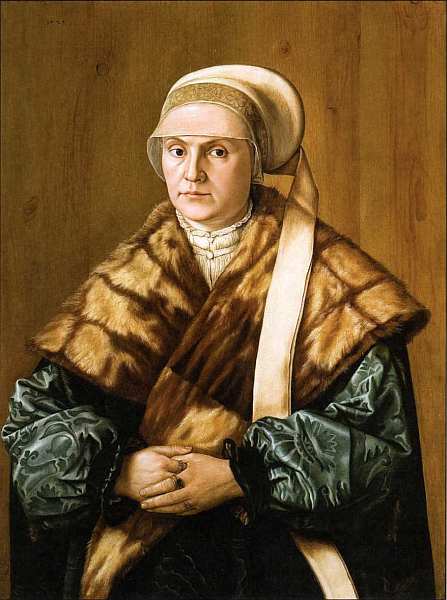
Bartel Beham is one of three pupils of Albrecht Dürer. These Nuremberg creators are best known as masters of engraving. They were convicted for atheism and expelled from the city. In the first quarter of the 16th century, Germany underwent a Reformation, and the time was marked by the triumph of humanism, the flourishing of science and art, so that the heritage of Becham is clearly secular.
Continuing the trends of Dürer’s mature art, the author departs from the flatness and fracture of the late Gothic, his works are well proportioned, and peace and clarity prevail.
The variety of textures – iridescent silk, soft fur, wood – combined with the rigor of the image attracts attention to this portrait, arousing interest in the mysterious personality. This statuesque lady, presumably, came from the family of Shad von Mittelbiberahi. A luxurious collar and a rich embroidered dress, a snow-white shirt, and gold jewelry make her a high society. The painting shows the master’s aspiration for perfecting the technique, which was influenced by Italian engraving. Careful detailing (the legacy of the Late Gothic) and a realistic manner are characteristic features of Beham’s art.
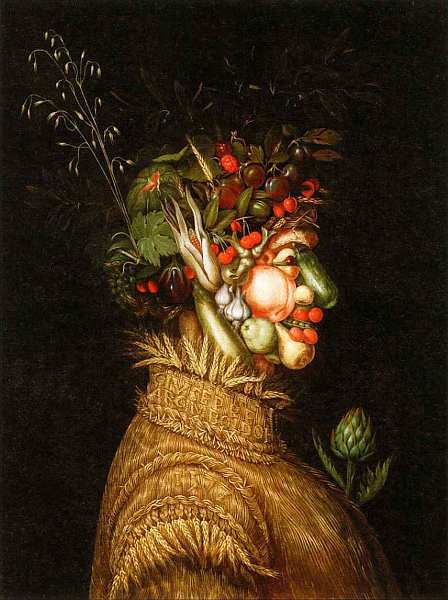
Giuseppe Arcimboldo was born in Milan. His father was painter Biaggio Arcimboldo, a follower of Leonardo. Already in 1562, Giuseppe became the court painter of Ferdinand I, King of Hungary, Bohemia, and Germany. It was then he created his famous paintings – allegorical images-booklets of flowers and fruits.
“Summer” is one of the paintings, belonging to the “Seasons” series. It was placed in the Imperial Kunstkammer symmetrically to the “Four Elements” cycle. In particular, “Summer” was a paired image for the work “Fire”.
These paintings have no direct predecessors, but they could have been inspired by the culinary art of solemn banquets, incredible compositions of dishes created by the artists.
The painter’s allegorical images are built according to a complex symbolic system designed to display the Neoplatonic ideas about the relationship between micro- and macrocosm. At the same time, these works, written in honor of the emperor, glorify the welfare and abundance of the Habsburg period.
Among the younger generation, admirers of more realistic art, Arcimboldo was a court jester, so he was thrown to the fringes of art history for a long time. He was rediscovered in the 1930s by surrealist artists who admired the master’s fantastic images.
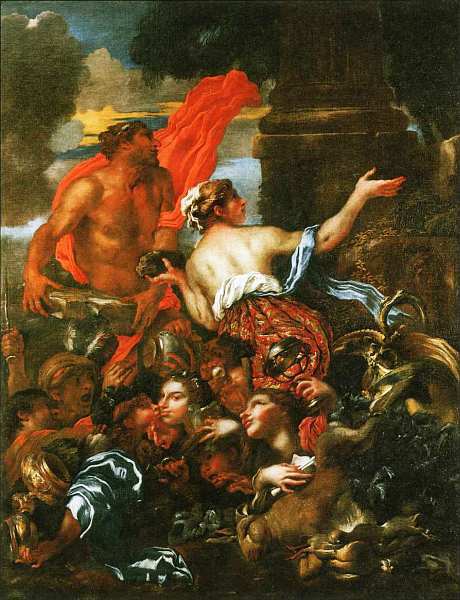
Giovanni Benedetto Castiglione is an Italian painter, representative of the Genoese school, one of the largest masters of pastoral painting. Nature and animals endlessly inspired the artist, which made them the leitmotif of his works. Paintings on biblical subjects as if a pretext for animalistic images: both here and there – the weave of horns, feathers, and hooves.
Rapid movement, bright glare, and intense shadows – everything points to the baroque nature of this painting: fluttering draperies, swirling bodies, the dramatic nature of lighting, some theatricality of the scene – faithful companions. Deucalion is the son of Prometheus, ruler of a Greek city and a kind of Noah in mythology: by the will of Zeus, who was inundated with the flood, he and his wife Pyrrha escaped in the ark that Prometheus had built. After the disaster, it was the responsibility of the spouses to restore the human race: women appeared from the stones scattered by Pyrrha, and men from the stones scattered by Devkalion. This is the moment that Castiglione illustrates.
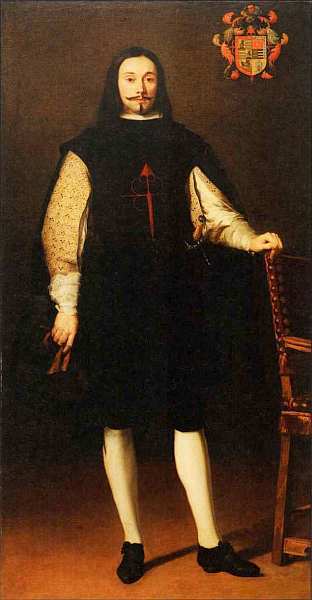
Bartolomé Esteban Murillo, a Spanish painter from the Seville school, lived his entire life in a small town south of Madrid. Only a few months he spent in the capital, improving his artistic skills. There the master met Velazquez and studied his private collection, which included paintings by Rubens, Titian, and Van Dyck, which had a huge impact on his style. Murillo is considered to be the last major Spanish painter of the XVII century. In his work, he tried to preserve the traditions of realism.
The portrayed Don Diego did not live to 35 years, he died in 1659, almost immediately after he became mayor of his native city – Vitoria. This portrait could have been made on the occasion of his election (about 1658-1659) or earlier – joining, following the example of his father and brother, the Order of St. James (in 1652), whose symbol – a red cross with the lower part in the form of a sword (embroidered on the chest model). The height image with the minimalistic background is executed in a quiet solemnity. The official character of the painting does not allow disclosing the manner in which Murillo’s works on biblical subjects were created. However, in the texture of the body shirt and lace one can notice sparkling light strokes reminiscent of Velazquez’s painting.
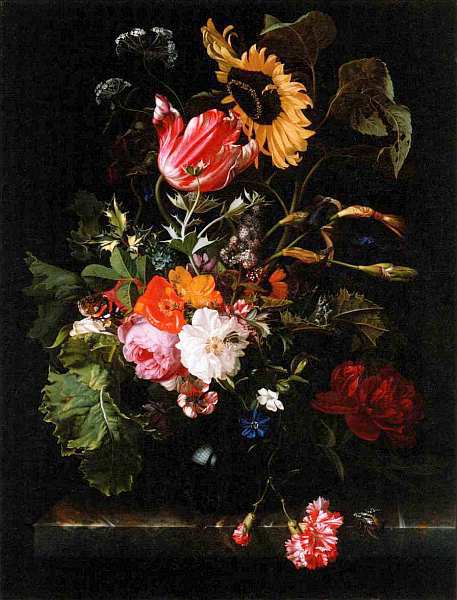
Due to the widespread of the profession of the artist in the Netherlands of the XVII century appeared and formed a wide range of specializations, appeared and formed the genres of painting. Still life was divided into many subtypes: some creators depicted only hunting trophies, others – precious utensils, third – still lifes vanitas, all elements of which reminded of the frailty of life.
The school of Utrecht masters, which included Jan David de Hem, Maria van Osterwijk’s teacher, traditionally focused on flowers. Her meticulously detailed luxury bouquets – encrypted meanings. For example, the tulip was considered a symbol of windiness, fleeting beauty, and youth, poppy – laziness, butterfly meant an immortal soul, opposed to a corruptible body; a number of flowers were dedicated to Our Lady and Christ.
As for the composition, van Oosterwijk uses the S-shape designed by de Chem, which adds a canvas of pictorial beauty and brings dynamics. In general, the painting presents a complex conceptual program, unfolding as a poetic work, composed of beautiful symbolic colors, which could easily be read by contemporaries.






